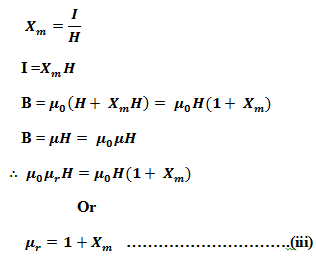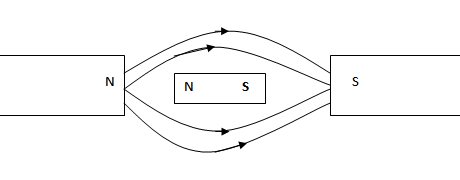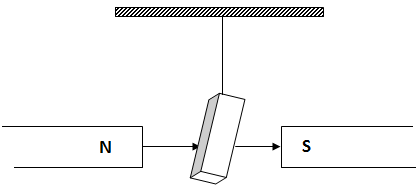CLASSIFICATION OF MAGNETIC MATERIALS
All substances are affected by magnetic field some attain weak magnetic properties and some acquire strong magnetic properties and some acquire strong magnetic properties.
The magnetic properties of the substances are explained on the basis of modern atomic theory.
The atoms that make up any substance contain electrons that orbit around the central nucleus.
Since the electrons are charged they constitute an electric current and therefore produce magnetic field .
Thus an atom behave as a magnetic dipole and possesses magnetic dipole moment.
The magnetic properties of a substance depend upon the magnetic moments of its atoms.
IMPORTANT TERMS USED IN MAGNETISM
The following terms are used in describing the magnetic properties of the materials:
(i) Magnetic flux density (B)
Is a measure of the number of magnetic field lines passing per unit area of the material.
The greater the number of magnetic field lines passing per unit are of the material
(ii) Magnetic permeability
Is a measure of its conductivity for magnetic field lines
The greater the permeability of the material the greater is its conductivity for the magnetic field line and vice versa
Since magnetic field strength B is the magnetic field lines passing per unit area of the material, it is a measure of magnetic permeability of the material.
Suppose magnetic flux density in air or vacuum is . If vacuum/air is replaced by a material, suppose the magnetic flux density in the material becomes B
. If vacuum/air is replaced by a material, suppose the magnetic flux density in the material becomes B
Then ratio B/ called the relative permeability
called the relative permeability  . of the material.
. of the material.
(i) Relative permeability .
.
Is the ratio of magnetic flux density B in that material to the magnetic flux density  that would be if the material were replaced by vacuum/ air .
that would be if the material were replaced by vacuum/ air .

Clearly  is a pure number and its value per vacuum/air is 1
is a pure number and its value per vacuum/air is 1

Relative permeability of a material may also be defined as the ratio of absolute permeability  of the material to absolute permeability
of the material to absolute permeability  of vacuum/air.
of vacuum/air.

(ii) Magnetizing force/ Magnetic intensity 
Is the number of ampere – turns flowing per unit length of the toroid.
The SI Unit of magnetizing force H is Ampere – turns per meter (AT/m)
Consider a toroid with n turns per unit length carrying a current I. if the absolute permeability of toroid material is M, then magnetic flux density B in the material is


The quantity  is called magnetizing force or magnetic intensity
is called magnetizing force or magnetic intensity
Therefore, the ratio  in a material I is from
in a material I is from
 ;
; B=
B=

Thus if the some magnetizing force is applied to two identical air cored and iron cored toroid, then magnetic flux density produced inside the toroid is

(iii) Intensity of magnetization ( ) is the magnetic moment developed per unit volume of the material.
) is the magnetic moment developed per unit volume of the material.
When a magnetic material is subjected to a magnetizing force , the material is magnetized
Intensity of magnetization is the measure of the extent to which the material is a magnetized and depends upon the nature of the material

where:
 = magnetic moment developed in the material
= magnetic moment developed in the material
V= volume of the material
If m is the pole strength developed,
 is the area of X – section of the material and 2l is the magnetic length. Then
is the area of X – section of the material and 2l is the magnetic length. Then


Hence Intensity of magnetization of a material may be defined as the pole strength developed per unit area of cross – section of the material.
Thus the SI unit of I is Am-1 which is the same as the SI unit of H
Magnetic susceptibility  is the ratio of intensity of magnetic on I developed in the material to the applied magnetizing force H
is the ratio of intensity of magnetic on I developed in the material to the applied magnetizing force H

The magnetic susceptibility of a material indicates how easily the material can be magnetized.
The unit of I is the same as that of H so that  is a number
is a number
Since I is magnetic moment per volume  is also called volume susceptibility of the material .
is also called volume susceptibility of the material .
Consider a current carrying toroid having core material of relative permeability 
The total magnetic flux density B in the material is given by

Where
 = magnetic flux density due to current in the coils.
= magnetic flux density due to current in the coils.
 = magnetic flux density due to the material (Magnetization of the material)
= magnetic flux density due to the material (Magnetization of the material)
 …………………(i)
…………………(i)
 …………………(ii)
…………………(ii)
Here I is the intensity of magnetization induced in the toroid material
B = +
+ 


Now,

Equation (iii) give the relation between relative permeability (μr ) and magnetic susceptibility (Xm).
CLASSIFICATION OF MAGNETIC MATERIALS
All materials or substances are affected by the external magnetic field. Some attain weak magnetic properties and acquire strong magnetic properties.
On the basis of their behavior in external magnetic field , the various substance classified into the following three categories
(i)Diamagnetic materials
(ii)Paramagnetic materials
(iii)Ferromagnetic materials
(i) DIAMAGNETIC MATERIAL
When a diamagnetic substance is placed in a magnetic field in the magnetic field lines prefer to passs through the surrounding air rather than through the substance.

Diamagnetic materials are materials which can not be affected by the magnetic field.
They are repelled by magnetic field e.g. lead, silver, copper, zinc, water, gold bismuth etc.
These substances when placed in a magnetic field are weakly magnetized in a direction opposite to that of the applied field.
PROPERTIES OF DIAMAGNETIC MATERIALS
1. A diamagnetic substance is feebly repelled by a strong magnet.
2. The magnetic susceptibility ( ) of a diamagnetic substance has a small negative value.
) of a diamagnetic substance has a small negative value.
3. The relative permeability ( ) of a diamagnetic substances is slightly less than 1
) of a diamagnetic substances is slightly less than 1
4. When a rod of diamagnetic substances is suspended freely in a uniform magnetic field, the rod comes to rest with its axis perpendicular to the direction of the applied field.
See figure below

This gives the relation between relative permeability  and magnetic susceptibility
and magnetic susceptibility  of the material.
of the material.
(ii)PARAMAGNETIC MATERIALS
Are materials which when placed in a magnetic field are weakly magnetized in the direction of the applied field
The paramagnetic substances include the Aluminum antimony , copper sulphate, Crown grass etc
Since the weak induced magnetic field is in the direction of the applied field, the resultant magnetic field in the paramagnetic substance is slightly more than the external field
Hence the magnetic susceptibility of a paramagnetic substance is positive having
It clear that the relative permeability  for such substances will be slightly more than 1
for such substances will be slightly more than 1
 = 1 +
= 1 + 
Paramagnetic substance loses its magnetism as soon as the external magnetic field is removed